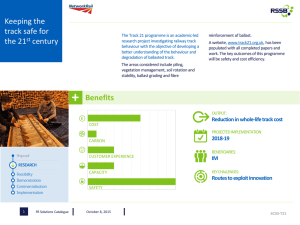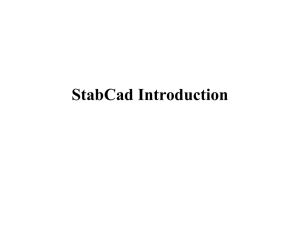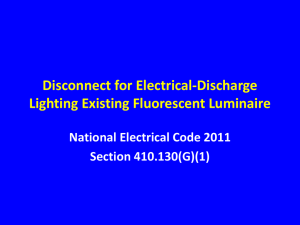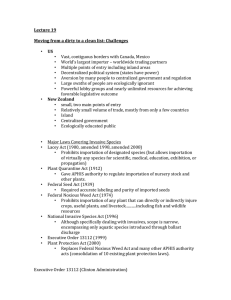REDUCING THE IMPACT OF SHIP-BORNE MARINE INTRODUCTIONS:
advertisement
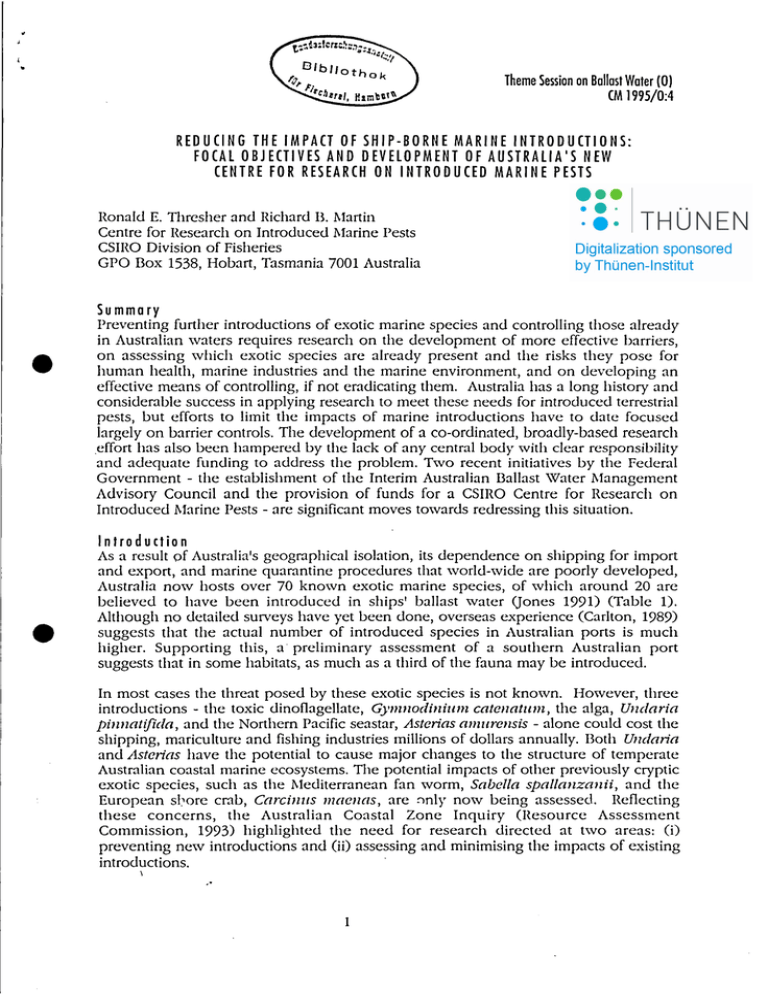
Theme Session on Ballast Water (0) CM 1995/0:4 REDUCING THE IMPACT OF SHIP-BORNE MARINE INTRODUCTIONS: FOCAl OBJECTIVES AND DEVElOPMENT OF AUSTRAlIA'S NEW CENTRE FOR RESEARCH ON INTRODUCED MARINE PESTS Ronakl E. Thresher and Richard B. Martin Centre for Research on Introduced Marine Pests CSIRO Division of Fisheries GPO Box 1538, Hobart, Tasmania 7001 Australia Su mma ry Preventing further introductions of exotie marine species and controlling those already in Australi~m waters requires research on the development of more effective barriers, on assessing whieh exotie species are already present and the risks they pose for human health, marine industries and the marine environment, and on developing an effective means of controlling, if not eradicating them. Australia has a long history and considerable success in applying research to meet these needs for introduced terrestrial pests, but efforts to limit the impacts of marine introductions have to date focused brge1y on barrier controls. The development of a co-ordinated, broadly-based research ,effort has also been hampered by the lack of any central body with cIear responsibiIity and adequate funding to address the problem. Two recent initiatives by the Federal Government - the establishment of the Interim Australian Ballast \Vater Management Advisory Council and the provision of funds for a CSIRO Centre for Research on Introduced Marine Pests - are significant moves towards redressing this situation. Introduetion As a result of Australia's geographical isolation, its dependence on shipping for import ami export, and marine quarantine procedures that world-wide are poorly developed, Australia now hosts over 70 known exotie marine species, of which around 20 are believed to have been introduced in ships' ballast water (Jones 1991) (Table 1). Although no detailed surveys have yet been done, overseas experience (Carlton, 1989) suggests that the actual number of introduced species in Australian ports is much higher. Supporting this, a preliminary assessment of a southern Australi~m port suggests that in some habitats, as much as a third of the fauna may be introduced. In most cases the tllfeat posed by these exotie species is not known. However, three introductions - the toxie dinoOagellate, Gynl1lodilliu11l catcllatu11l, the alga, Undaria pimwtifida, and the Northern Pacific seastar, Astcrias a11lurcllsis - alone could cost the shipping, mariculture and fishing industries millions of dollars annually. Both Ulldaria and Astcrias have the potential to cause major changes to the structure of temperate Australian coastal marine ecosystems. The potential impacts of other previously cryptie exotie species, such as the l\lediterranean fan worm, Sabclla spallmzzallii, and the European sl~ore crab, CarCill11S nWC1UlS, are nnly now being assessed. ReOecting these concerns, the Australian Coastal Zone Inquiry (Resource Assessment Commission, 1993) highlighted the need for research directed at two areas: (i) preventing new introductions and (ii) assessing amI minimising the impacts of existing introductions. ' \ " Preventing new introductions . Australia has taken a high profile internationally in an effort to minimise the risks of ballast water introductions. The Australian Quarantine and Inspection Service (AQIS), through its chairmanship of the Marine Environment Protection Committee of the International Maritime Organisation, has been a strong advocate for international controls on the discharge of ballast water. As well, in 1994 AQIS convened anational Ballast \Vater Symposium in Australia, to highlight the importance of the issue and to progress action on it. The major outcome of the symposium was a Dmft Natio1lal Stmtegy Oll Ballast 'Vater ,Ma1lageme1lt. The draft strategy recommended the establishment of an Australian Ballast \Vater Management Advisory Council, supported by a Research Advisory Group and core funding for research. Pending national endorsement of this strategy, an interim council has been set up to progress urgent issues. The interim council consists of government departments with a stake in the ballast water issue (quarantine, transport, marine safety, environment), key industry groups (shipping, port authorities, fishing and mariculture industries) and a senior science representative (CSIRO). The Research Advisory Group consists primarily of industry representatives and a broader spectrum of relevant science agencies. The interim council has focused its attention on three objectives: allocation of responsibility for ballast water management; • • development of a secure funding base for long-term research; and • devclopment of a strategie research plan. • Responsibility for ballast water management The question of who should, or in fact, who can take responsibility for devcloping and enforcing ballast water regulations or guidelines in Australia has yet to be resolved. Cogent arguments can be made for this role being either a federal or astate responsibility. The underlying problem is that the plethora of acts and regulations that are relevant to introduced marine pests and their transport vectors are administered by a number of different state and federal departments. All have some regulatory responsibilities in relation to the issue, but it is not clear where the authority to respond lies, or whieh agency can respond most effectively. A similar problem arises in relation to the role of port authorities, the potential implementers of any management strategy. These authorities differ in their responsibilities [rom state to state and it is unclear if any have the legislative authority to enforce ballasting controls. The interim council has invited comments on this issue from all relevant state departments and has established a sub-committee, chaired by astate representative, which will make recommendations to the Council and, through it, to the federal government for implementation. Funding for lang-term research The Australian Government has a "user-pays" approach to the provision of government services and research. This means, in the case of marine introductions, that if international shipping or its clients are viewed as the main perpetrators of the problem, they should bear the brunt of the cost of remediation and contro!. Such an approach, however, presupposes a capacity to allocate responsibility for specific introductions, which requires unequivocal identification of transport vectors and a detailed knowledge of high risk vessels and shipping routes. An alternative approach, canvassed by the councH, is a broadly based levy on the shipping industry. Opponents of the levy rightly point out that it imposes an additional cost on "good corporate citizens", who already take suitable precautions to minimise risks, while providing no incentive for those "less responsible citizens ll to do Iikewise. The issue is 2 • further compIicated by different levels of interest shown by relevant industries in funding baseline as opposed to barrier-related research, and meeting costs associated with inspection, verification, and barrier co-ordination. " • .0, ........ • Development of astrategie research plan Virtually everyone involved in the issue sees research and technology as the keys to resolving the introduced pest problem. The research required falls into two broad categories: baseIine and barrier development. The first relates to the state of the current problem: How many ports are infected, and by what?, What is the major transport vector ?, and \'V'hat international routes and carriers pose the greatest risks? The second deals with prospects for risk minimisation through development of a decision support system for re-ballasting, and by examining management options at the port of up-take, during transport, and in the receiving port. This approach is broadly consistent with that taken elsewhere (Carlton, 1989). The interim council plans to have these issues resolved, and a draft strategie plan in place, by the 'end of 1995. . Assessing and minimising the impacts of existing introducfions The evaluation and control of introduced marine pests requires a multi-disciplinary approach involving areas as diverse as taxonomy, environmental impact assessment, economics and engineering. In 1994, the Australian Government allocated funds to the CSIRO (Commonwealth Scientific and Industrial Research Organisation) to conduct this research on anational scale. To do so, a Centre for Research on Introduced l\Iarine Pests (CRIl\IP) was set up within the CSIRO Division of Fisheries. The objectives of the Centre are: (i) To develop and promote implementation of tools for earlier warning, better predietion, and more effective assessment of risks and costs of marine pest species introduced to Australia. (ii) To develop new methods or improve existing measures to contral the spread and minimise the impacts of introduced marine species. Achievement of these objectives involves evaluating the environmental and economie threats posed by known introduced pest species; developing cost-effective monitoring programs for early detection of these species in high-risk areas; providing the ecological basis for assessing the effectiveness of existing and new control measures; and developing and promoting new contral measures nationaIly an~ internationaIly. CRIMP is taking a staged approach to the problem, focusing on key objectives and coIlaborating, wherever possible, with other research initiatives in order to maximise the value of the research doIlar. Discussions with the centre's primary c1ients lead to a research plan that has three main thrusts: (i) an assessment of the scale of the problem in Australian waters; (ii) investigation into ways to minimise the risk of domestie translocation of exotie species; and (Hi) the development of biological controls against pest species. Assessing the scale of the introduced species problem To assess the number, diversity and distribution of the introduced marine species in Australian waters, CRIMP is undertaking three interrelated studies, two of which will be jointly funded with other agencies: 3 co I1lte1lsive 'port surveys. These surveys will provide an indieation of the magnitude of the problem in a small number of representative ports. The first port to be examined will be Port Phillip Bay, in south-eastern Australia. Port Phillip Bay was chosen because of the availability of good local taxonomie knowledge, access to support infrastructure, its role as a major port for both domestie and international shipping, and a historieal data base against whieh the current species assemblage can be compared. For logistieal and taxonomie reasons, the survey will concentrate on a few major groups - primarily fish, selected macro-invertebrate groups and the macroalgae - and will be largely qualitative (mainly presence-absence). The Port Phillip Bay study will be completed by the end of 1996, after which the focus will shifted to '1 tropieal port (most likely Darwin). (H) Natio1lal ports sun:ey. CRIl\lP and the Australian Association of Port Management Authorities are jointly funding a survey of all major shipping ports in Australia. The survey will be semi-quantitative, and have three objectives: • to determine the geographieal distribution of a set of identified "pest" and exotic species (Table 1); • to obtain opportunistie information on other introduced species in the ports; and • to make a preliminary risk assessment for each port on likelihood of translocation of existing pests and to recommend ways to reduce these risks. The national port survey will start in 1995, will be completed by 1997, and may lead to an on-going monitoring program. Ciii)' Com11l111lity-based coastal m01litori1lg. In 1995, the Australian Government provided funding for anational 'Coast Care' initiative, to facilitate community involvement in coastal management. As part of this program, CRIMP and the relevant commonwealth department are developing anational "early warning l' network for introduced species. Fifty four regional co-ordinators are being appointed, who will develop links between CRIl\lP (and other scientific agencies) and local community groups, such as dive clubs, fishing groups and ScIlOOls. CRIMP will provide technieal expertise and identification material to support the efforts of volunteers to map the presence of known pests and keep an eye open for new ones. It is hoped that the broad geographieal coverage of the network will make possible the rapid detection of any new introductions and provide opportunities to eradicate such species before they can establish and spread. Minimising the domestic translocation of exotic species CRIl\lP is progressing this issue in three ways. First, studies are underway to assess the relative importance of huH fouling and domestie ballast water exchange in the coastal transport of the main pest species. This study involves surveys of hulls for fouling organisms, particularly known pest species, and experiments to determine whether the larvae of these species survive in and remain viable in the ballast tanks of coastal vessels. Preliminary indieations are that huH fouling is Iikely to be the main transport vector for several of the major pest species. . Second, discussions are underway with mariculture co-operatives to deveIop treatment protocols to mini mise the risk of accidental transport of eggs, larvae or juveniles of pest species in the live fish or shellfish trade. Third, we are initiating a long-term project to look at the impact of port management practiees on the" colonisation success of invading species. Theoretieal and empirieal 4 • . ~:".'o'. : considerations suggest that vacant habitat created by disturbance may be a major factor in facilitating colonisation by exotic species. Field and experimental studies are being planned to examine this with a view to recommending changes in port practices that would lower the risk of invasion" by introduced species. Biological Contral • • The CRI1\IP advisory committee recommended that in the medium to long term, significant centre resources should be allocated to assess the feasibility of developing biological control techniques for established pest species. CIUMP is currently recruiting specialist staff to develop this program, which is expected to draw heavily of the extensive experience of other CSIRO Divisions that work on the integrated pest management of terrestrial pests. Initial efforts will focus on natural parasites and pathogens, with the intent of moving to transgenic technology only if necessary. \Vork on transgenic teehnology is underway in several CSIRO Divisions, but the ethical problems associated with this approach (Goodman, 1993) and the praetical difficulties involved in adapting the teehnology to marine organisms warrant a detailed seareh for natural parasites first. While awaiting appointment of key staff, CIUMP has commenced several information gathering projeets. Field teams have been eommissioned to examine native populations of the northern Pacifie seastar, Asterias amurellsis, in Russia and Japan to identify potential biological control agents. At this stage, the most likely eandidates are eulimid gastropods and ascothoracidan barnacles, both parasitic castrators. A small projeet to assess the feasibility of mass rearing marine parasitcs for release has also been commissioned, as part of a eollaborative study with Armand Kuris's laboratory at the University of California- on the potential for biological control of the European shore erab, CarCill11S 11laellas. \Ve will also be shortly having discussions with specialist parasitologists working on several, possibly relevant groups, with a view to funding projeets relevant to the biological control initiative. In Australia, monitoring programs are being put in place for the two species that are likely first targets for attempted biological control (Carcinlls and Asterias) so that adequate baseline information is available on the population dynamics of these species against which the impacts of the biological control agent can be assessed. It is diffieult to predict the time course of the biological control project, given vast uncertainties in everything from the availability of parasitcs to the likelihood that they ean be reared in eaptivity. Optimistically, CIUMP hopes to undertake trial releases of parasites in 3-4 years, with full seale release 1-2 years later, following detailed impact assessments. References Carlton, ].T. (989). Man's role in changing the face of the ocean: biological invasions and implieations for conservation of near-shore environments. COllsero. Biol. 3: 265-273. Goodman, ß. (993). Debating the use of transgenic predators. Sciellce 262: 1507. Jones, 1\1. (1991) llfarille orgmzis11ls trallsported in ballast water. Bur. Rural Res. Bull. 11, Australian Government Publishing Service, Canberra, 48 p. Resource Assessment Commission. (993) Coastal Zone Inquiry Final Report. Australian Government Publishing Service, Canberra, 519 p. 5 Table 1. Known introdueed marine species in Australian waters; their possible origin, Iikely mode of introduction, and eurrent Australian status. Taxon Spedes ANIMALS Coelenterato Hydrozoo Bougainville ramosa (hydroid) Annelida Polychaeta Hydroides norvegica (serpulid) Mereierella enigmatica (serpulid) Boccardia proboscidea (spionid) Polydora eilliata (spionid) Pseudopolydora paucibranchiata (spionid) Sahella spallanzanii (giant fan warm) 2 Mollusea Gostropoda Maoricolpus roseus (screw shell) leacumantis subcarinatus (screw shell) Aeolidiella indica (sea slug) Janolus hyalinus (sea slug) Okenia plana (sea slug) Polycero capensis (sea slug) Godiva quadricolor (sea slug) Thecacera pennigera (sea slug) Bivalvia Crassostrea gigas (Pacifie oyster) Neilo australis (elam) Ostrea futaria (NZ mud oyster) Paphirus largellierti (elam) Perna canaliculus (NZ green musseI) 1 Musculista senhousia (Asian musseI) Theara lubrica (semelid) Polyplaeophora Amaurochiton glaucus (chiton) Crustacea Mysidaeea Neamysis japonico (mysid shrimp) Tanaidacea Tanais dulongi (tanaid) Isopoda Cirolana hardFordi (jsopod) Eurylana arcuata (isapad) Paracerceis sculpta (jsopod) ParadeIfa dianae (jsopod) Sphaeroma serratum Osopod) Sphaerorna walkeri Osopod) Cirripedia Ba/anus improvi5us (barnacle) Megobalanus rosea (barnaeIe) hfegabalanus tintinnabulum (barnacle) Notomegaba/anus a/gico/a (barnacle) Decopodo Cancer novaezelandiae (crab) 1 Careinus maenas (Europeon share crab) 2 Australian status Possible origin Mode of Introduction N. Hemisphere hull Europe Indio Japan/NE. Paeine Europe Japan/NE. Paeific/NZ Mediterranean ballast; hull ballast?; hull ballast; hull ? ballast; hull ballast ? ? abundant ? ? abundant; pest NZ NZ widespread Europe Japan California S. Africa ? with oysters ? ballast; hull hull hull hull hull? hull abundant ? common ? ? ? ? ? Japan NZ NZ NZ NZ Pacifie/Asia Paeific/Asio deliberate with oysters deliberote with oysters with oysters; hull? hull; ballast ballast eommerciol; pest? common ? ? NZ with oysters Japan ballast Europe ballast common USA NZ/Chile USA/So America USA/So America widespread Indian Ocean hull hull; ballast hull hull huB hull ? ? ? ? ? ? Atlantic Jopan cosmopolitan S. Africa hull hull? hull hull ? ? ? NZ Europe with oysters hull?; ballast? common common; pest common ? ? • • • lable 1 continued Haficarcinus innominatus (crab) Pyromoia tubercufata (crab) Pafaemon macrodoctyfus (Japanese shrimp) NZ E. Paeifie N. Paeifie with oysters; hull ballast ? ? ? eommon? Anguineffo pofmoto Bugufa ftabeffata Canopeum tubigerum Schizoporeffa unicomis Watersipara arcuata Atlantie Atlantie/Mediterranean Atlantie Japan Mexieo hull hull hull hull? hull ? ? ? ? ? Japan NZ NZ ballast ? with oysters abundant; pest eommon eommon N. Atlantie NW. Pacifie/Europe widespread hull hull hull ? ? ? Japan W.-[qual. Paeifie Arabian Gulf W.-Equal. Pacifie W.-Equal. Paeifie NZ SE Asia N. America NZ (California) ballast ballast ballast ballast ballast ? deliberate deliberate deliberate deliberate established established ? established established eommon common; pest? commercial eammon eommercial S. Africa Atlantie/lndo Paeifie hull? hull? abundant abundant Japan? Mediterraneon? Japan? ballast ballast? ballast? abundant; pest abundant; pest abundant; pest N. hemisphere N. hemisphere N. hemisphere N. hemisphere N. hemisphere ? ? ? ? ? ? ? ? ? ? Japan Mediterranean Mediterranean Mediterranean ballast, hull? ? ? ? abundant; pest ? ? ? Bryozoa Eehinodermata Asteroidea Asterias amurensis (northern Paeifie seastar) 2 Astrostofe scabra (seastar) 1 Patirieffa regufaris (seastar) Chordata Aseidiaeea • •Mofgufa manhattensis (aseidion) Styeta efava (ascidian) Styefa pficata (ascidian) Pisees latelabrax iaponicus (Japanese sea bass) Triso dermopterus Sparidenrax hasta (Sobaity sea bream) Tridentiger trigonocephalus (striped goby) Acanthogoboius ffavimonus (yellawfin gaby) Fosterygion varium (blenny) Oreochromis mossambicus (tilapia) Sofmo sofar (Atlantie salmon) Safmo trutta (brown traut) Oncorhynehus mykiss (rainbow trout) UK PLANlS Phyeophyta Chlorophyeeae Cauferpa fitiformis Caulerpa taxifolia1 e Dinophyeeae Gymnodinium catenatum (dinoflagellate) 2 Afexandrium minutum (dinoflagellate) 1, 2 Afexandrium cataneffa (dinoflagellate) 1, 2 Rhodophyeeae Arthraefadia viffosa Sperococcus compressus Antithomnioneffa spirographidis Pofysiphonia bradiaei Polysiphonia pungens Phaeophyceae Undaria pinnatifida (Hwakame H) 2 Discosporangium mesarthrocarpum Spaceffa subtilissima lasterocarpus spp. Notes: 1 Intradueed status uneertain; possibly on Australion endemie. 2 IABWMAC target pest species
